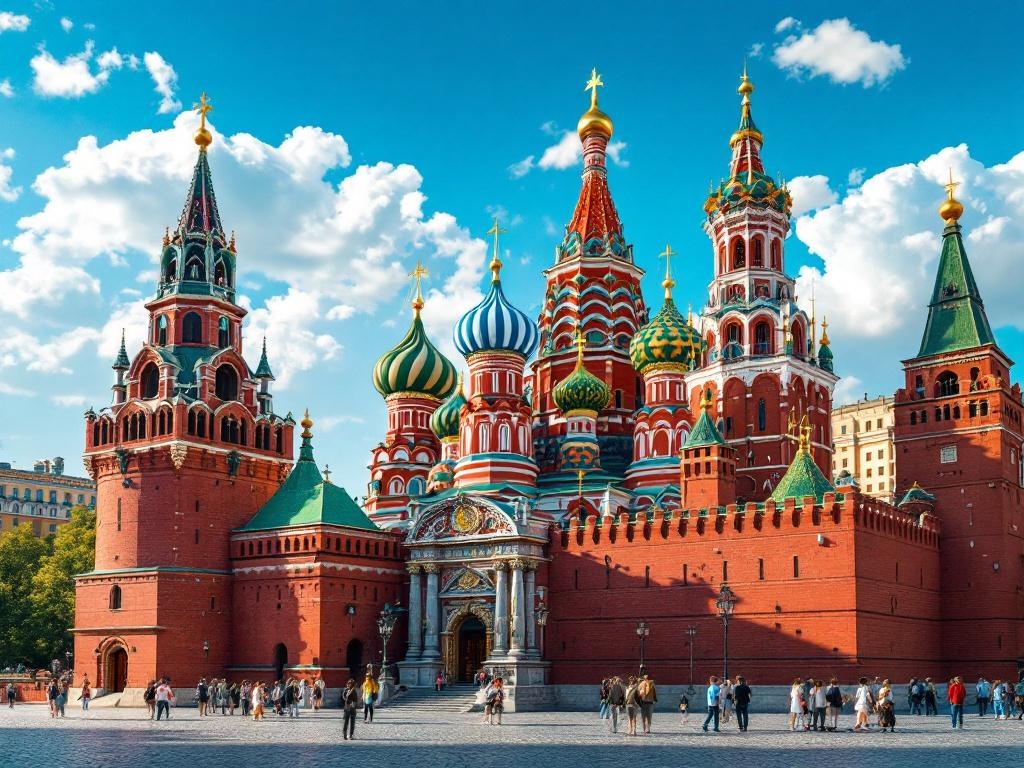Discovering the Kremlin in Moscow
Journey through time at Moscow’s Kremlin, a UNESCO World Heritage Site and iconic fortress steeped in Russian history. Explore opulent palaces, sacred cathedrals, and the Armoury Chamber’s dazzling treasures. Discover the Kremlin’s evolution from a 12th-century wooden fort to a symbol of power. Plan your visit today and experience this must-see destination.
Important information

- The Moscow Kremlin, a historic fortress, is a UNESCO World Heritage Site and a symbol of Russia’s power.
- Key attractions include the Grand Kremlin Palace, the Armory Chamber (housing the Diamond Fund), and Cathedral Square with its historic cathedrals.
- The Kremlin’s walls and 20 towers showcase its architectural significance, blending white stone and red brick.
- Visitors can explore museums, cathedrals, and grounds, including the Taynitsky Garden and iconic landmarks like the Tsar Cannon and Tsar Bell.
- Plan ahead, dress respectfully, and consider a guided tour for a richer experience.
Discovering the Kremlin in Moscow: An Iconic Fortress
Moscow’s Kremlin, a majestic fortress on the Moscow River, attracts millions of visitors annually. This iconic landmark is central to Russia’s history and power, offering a glimpse into the nation’s rich heritage. Explore its stunning cathedrals, opulent palaces, and expansive grounds through guided tours that illuminate Russia’s past and present.
Key Attractions
- Grand Kremlin Palace.
- Armory Chamber.
- Ivan the Great Bell Tower (breathtaking panoramic views).
Cathedral Square
- Cathedral of the Assumption.
- Other notable churches.
Inside the State Armory Museum, marvel at royal treasures, weaponry, and ceremonial artifacts. Special exhibitions and events further enrich the visitor experience, creating a captivating journey through Russian history. The Kremlin’s diverse architecture reflects its long and storied past, with its formidable walls and towers symbolizing its enduring legacy. Before you travel, make sure you have the necessary visa or permits. Check the latest entry requirements here: Find out entry rules for your destination
The Moscow Kremlin: Heart of Russian History
The Moscow Kremlin, located in the heart of Russia, has served as a pivotal point in the country’s history and political landscape.
Initially a modest wooden fort in the 12th century, the Kremlin evolved into the magnificent stone citadel we recognize today.
Its imposing walls and 20 towers stand as enduring symbols of Russia’s power.
Within the Kremlin walls, Cathedral Square is home to important religious structures.
These include the Cathedrals of the Dormition, Annunciation, and Archangel Michael, each playing a significant role in Russia’s rich history.
UNESCO World Heritage Status
In 1990, the Moscow Kremlin and Red Square were designated a UNESCO World Heritage Site, recognizing their significant cultural and historical value. Millions of tourists visit these iconic landmarks annually.
Historic Significance of the Moscow Kremlin
From its humble beginnings as a 12th-century wooden fort, the Moscow Kremlin evolved into the mighty stone citadel it is today, a testament to its enduring significance in Russian history. For centuries, this center of power has symbolized the Russian state, witnessing the rise and fall of empires, revolutions, and political shifts within its very walls. Ivan III the Great’s reconstruction solidified the Kremlin’s authority, ultimately transforming it into a potent symbol of Soviet power.
From Wooden Fortress to Stone Citadel
In the 12th century, the Moscow Kremlin was a modest wooden fort. By the 14th century, it transformed into a formidable stone citadel. This impressive reconstruction, using white stone, marked a major architectural advancement.
Reconstruction Under Ivan III the Great
Ivan III the Great initiated the Moscow Kremlin’s reconstruction, commissioning Italian architects. These architects designed and built its magnificent fortifications and cathedrals. This transformation elevated the Kremlin from a simple wooden fortress to a majestic stone citadel. It solidified Moscow’s status as the capital of a newly unified Russia.
The Kremlin as a Soviet Symbol
Following the Russian Revolution, the Kremlin’s significance shifted dramatically, evolving from a Tsarist fortress into the potent symbol of Soviet power. The Soviet government established its headquarters there, embodying the newly dominant communist ideology at the heart of the USSR.
Architectural Marvels within the Kremlin
Twenty monumental towers, each with a unique design and rich history, define the Kremlin. These towers played a crucial defensive role and contribute to the Kremlin’s majestic splendor.
The Kremlin walls, primarily constructed of red brick, are punctuated by sections of white stone, creating a striking visual contrast. This contrast reflects the fortress’s complex construction history. Together, the towers and walls symbolize the Kremlin’s enduring strength and architectural significance.
The 20 Monumental Towers
Twenty grand towers punctuate the Moscow Kremlin skyline. Each bears a unique history and serves as a vital defense, a testament to the Kremlin’s power and enduring strength.
White Stone Walls and Red Bricks
The Moscow Kremlin’s walls are a striking blend of white limestone and red brick, showcasing the evolution of its architectural style. Primarily constructed in the late 15th and early 16th centuries, the walls display a distinct Italian influence. Later, 17th-century additions of red brick introduced elements of traditional Russian design, creating a captivating fusion. This interplay of white and red tells a story of changing tastes and influences across the Kremlin’s history.
Exploring the Sacred Spaces of Cathedral Square
Moscow’s Kremlin’s Cathedral Square is a must-see, showcasing magnificent structures deeply woven into Russian history and culture. The square houses the Cathedral of the Dormition, the coronation site of Russia’s tsars. Also on the square is the Cathedral of the Annunciation, which served as the imperial chapel. Finally, the Cathedral of the Archangel Michael served as the tsars’ final resting place.
Cathedral of the Dormition: Coronation Site
Moscow’s Cathedral of the Dormition, located in Cathedral Square, was the main venue for the coronations of Russia’s tsars.
Cathedral of the Annunciation: Imperial Chapel
The Tsars’ private chapel, the Cathedral of the Annunciation, highlights the church’s profound influence on the Russian Imperial Family.
Cathedral of the Archangel Michael: Tsar’s Burial Ground
The Cathedral of the Archangel Michael houses the tombs of numerous Russian tsars, emphasizing its significance in the nation’s royal history.
Palaces and Museums of the Kremlin
Within the Kremlin’s walls, the Grand Kremlin Palace stands as a potent symbol of power, once home to the Tsars and now serving as the Russian President’s official ceremonial residence. Nearby, the Armoury Chamber, one of Russia’s oldest museums, houses a vast collection of historical treasures. These treasures include royal artifacts, weaponry, and the dazzling Diamond Fund, a showcase of the nation’s most precious gems.
Grand Kremlin Palace: A Seat of Power
The Grand Kremlin Palace, a powerful symbol of Russia, is the official residence of the Russian President and a key part of the Kremlin complex.
The Armoury Chamber: Home to the Diamond Fund
The Moscow Kremlin’s Armoury Chamber houses the Diamond Fund, an astounding collection of priceless jewels, gems, and other precious artifacts. These remarkable items offer a glimpse into Russia’s opulent past, revealing a captivating narrative of wealth and power.
Cultural and Spiritual Significance
The Kremlin stands as a symbol of Russia’s enduring power, housing sacred treasures of the Russian Orthodox Church. These artifacts underscore its deep connection to the nation’s spiritual heritage, a link of profound importance.
The Kremlin as a Symbol of Resilience
A testament to Russia’s enduring strength, the Kremlin has weathered invasions, fires, and sieges. This historic fortress, a symbol of power, embodies the nation’s continuous history.
Having served as both a fortress and palace, the Kremlin now stands as the official residence of the President, showcasing its remarkable adaptability. Its significance in Russian culture and identity remains profound.
Religious and Spiritual Treasures of the Russian Orthodox Church
Within the Kremlin walls, Moscow’s magnificent cathedrals safeguard Russia’s rich spiritual heritage. The Cathedral of the Dormition, a place of profound reverence, houses the venerated icon of Our Lady of Vladimir. The Cathedral of the Archangel Michael, intertwined with the nation’s history, serves as the final resting place for numerous Russian tsars. The Cathedral of the Annunciation, once the private chapel of the tsars, showcases unique iconography, reflecting the close relationship between religious and political life. These sacred spaces preserve the enduring traditions of the Russian Orthodox Church.
Visiting the Kremlin: A Journey Through Time
Explore the Kremlin’s historical grounds, museums, and stunning architecture. Enhance your experience with a guided tour for enriching context, or explore independently with individual tickets. Discover magnificent cathedrals in Cathedral Square and explore museums filled with Russian artifacts and art. Comfortable shoes are recommended for navigating the vast grounds.
Plan Your Visit
Plan your visit in advance and arrive early to avoid large crowds. Check the official website for current opening hours, special events, and any access restrictions. Tickets can be purchased online or at the ticket office.
Respectful Attire
Dress respectfully when visiting the churches within the Kremlin complex. Remember, this site holds significant historical and religious importance.
From Fortress to Symbol
Discover the Kremlin’s evolution from a 2nd-century wooden fort to the residence of Russian rulers and a powerful national symbol.
Seasonal Visiting Hours
Visiting hours vary seasonally, often extended during the summer months. Consult the official website for the most up-to-date information.
Hidden Gems and Iconic Landmarks
Explore the hidden gem of Taynitsky Garden and marvel at iconic landmarks like the Tsar Cannon and Tsar Bell.
Guided Tours and Tourist Attractions
Experience the Kremlin’s captivating history and stunning architecture. Choose a guided tour to explore magnificent cathedrals, the Armoury Chamber, and other landmarks with expert guides sharing fascinating stories and insights. Or, explore independently, wandering the grounds, discovering hidden museums, and relaxing in the tranquil gardens. Standard security checks are in place, so arrive early to avoid delays. Remember the dress code, especially for religious sites.
Discovering the Taynitsky Garden
Within the Kremlin’s walls lies a tranquil sanctuary: the Taynitsky Garden. This serene space preserves important landscapes from the Kremlin’s history, reflecting its rich past.
Iconic Landmarks: Tsar’s Cannon and Tsar’s Bell
Forged in 1586, the Tsar Cannon is a marvel of engineering and one of the largest cannons ever made. Ironically, it never fired a shot in battle.
Cast in 1735, the Tsar Bell holds the record as the world’s largest bell, but met a tragic fate. A fire in 1737 cracked the giant bell, silencing it forever.
These impressive creations showcase Russia’s exceptional craftsmanship and artistic legacy.












